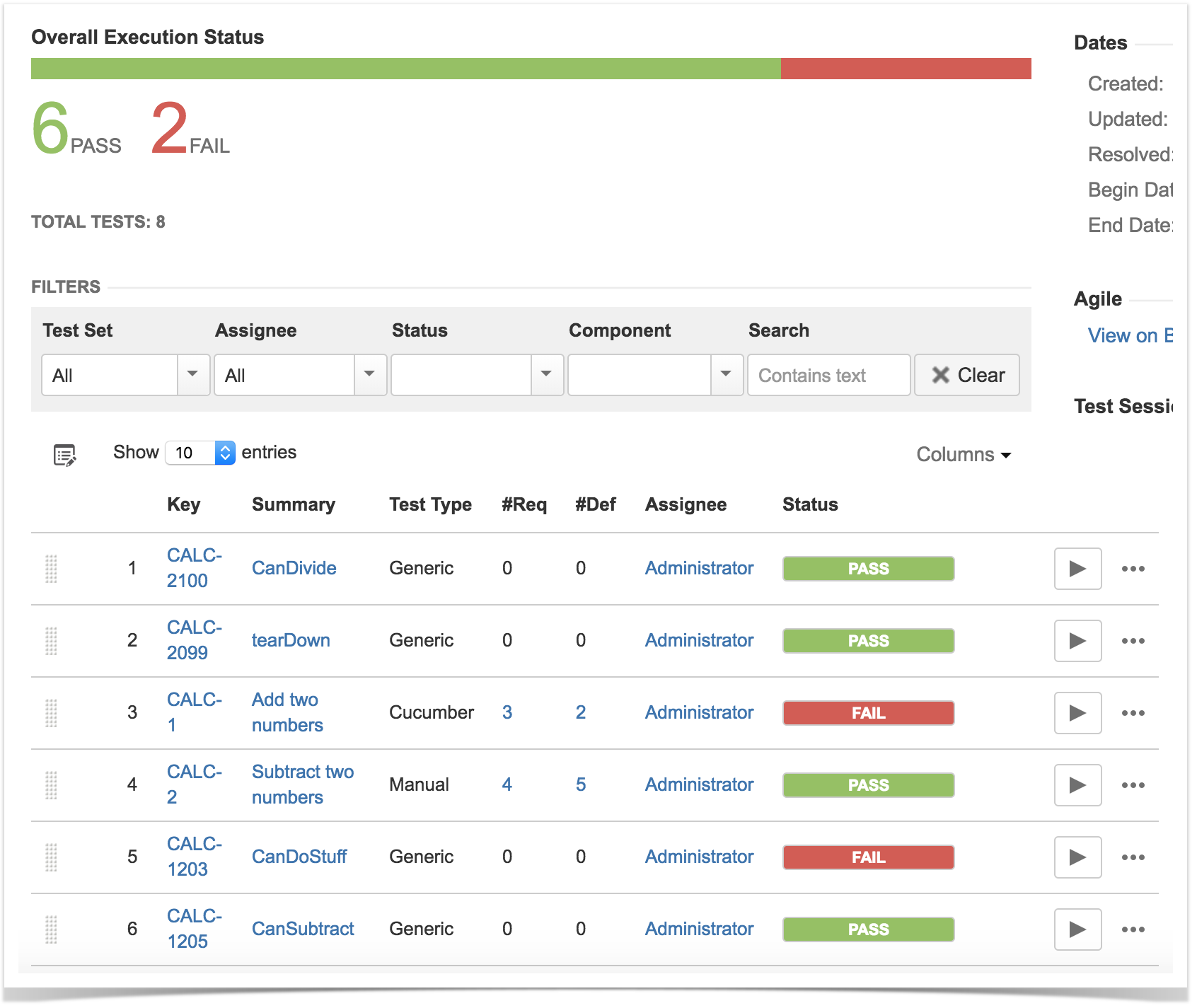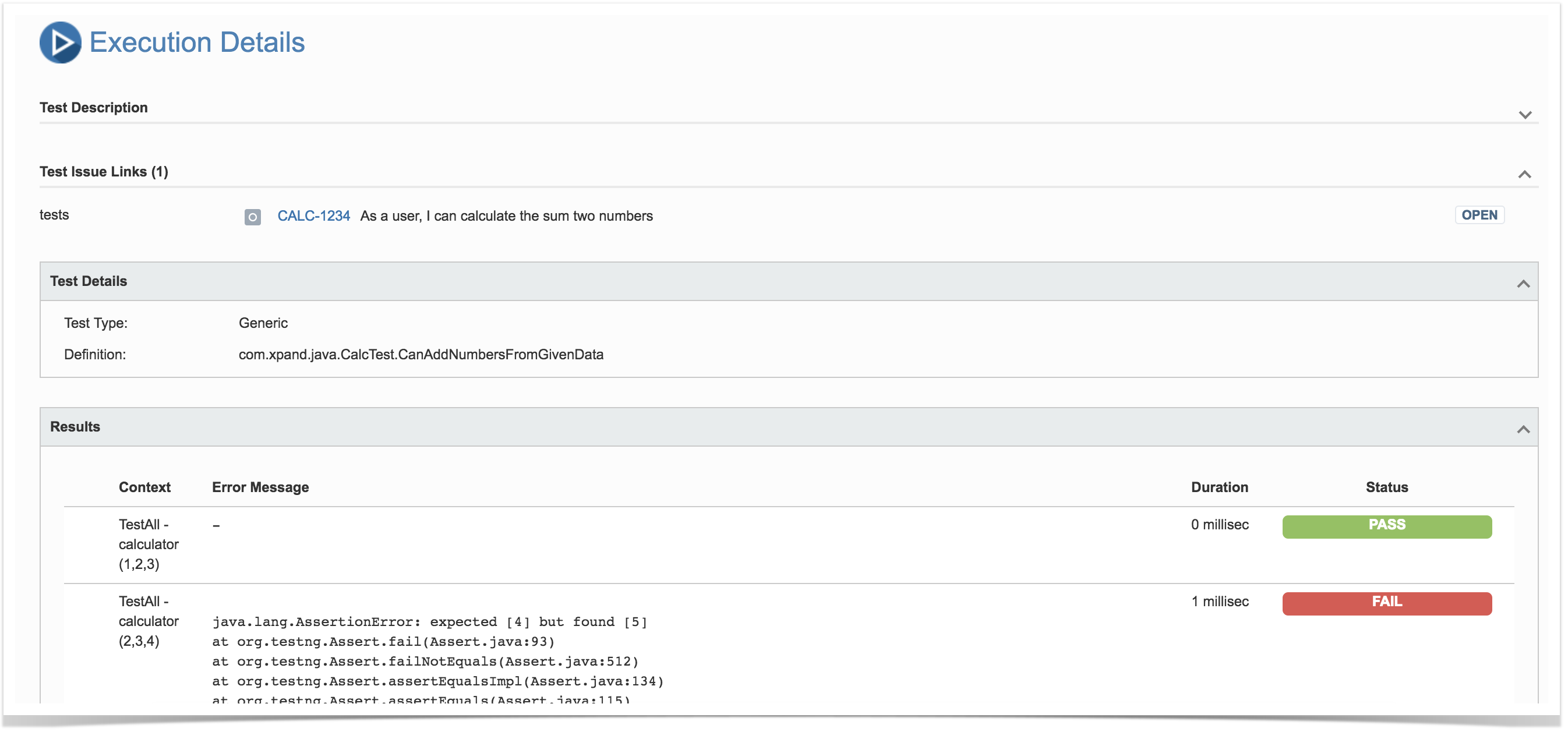Page History
...
| Code Block | ||||||
|---|---|---|---|---|---|---|
| ||||||
package com.xpand.java;
import org.testng.Assert;
import org.testng.annotations.Test;
import org.testng.annotations.BeforeSuite;
import org.testng.annotations.AfterSuite;
import org.testng.annotations.DataProvider;
import org.testng.Reporter;
import org.testng.reporters.XMLReporter;
import org.testng.ITestResult;
import com.xpand.annotations.Xray;
public class CalcTest {
@BeforeSuite
public void setUp() throws Exception {
}
@AfterSuite
public void tearDown() throws Exception {
}
@DataProvider
public Object[][] ValidDataProvider() {
return new Object[][]{
{ 1, 2, 3 },
{ 2, 3, 4 }, // error or the data itself :)
{ -1, 1, 0 }
};
}
@Test(dataProvider = "ValidDataProvider")
@Xray(requirement = "CALC-1234", test = "CALC-1")
public void CanAddNumbersFromGivenData(final int a, final int b, final int c)
{
Assert.assertEquals(Calculator.Add(a, b), c);
}
@Test
@Xray(requirement = "CALC-1234", test = "CALC-2", labels = "core addition")
public void CanAddNumbers()
{
Assert.assertEquals(Calculator.Add(1, 1),2);
Assert.assertEquals(Calculator.Add(-1, 1),0);
}
@Test
@Xray(requirement = "CALC-1235", labels = "core")
public void CanSubtract()
{
Assert.assertEquals(Calculator.Subtract(1, 1), 0);
Assert.assertEquals(Calculator.Subtract(-1, -1), 0);
Assert.assertEquals(Calculator.Subtract(100, 5), 95);
}
@Test
@Xray(requirement = "CALC-1236")
public void CanMultiplyX()
{
Assert.assertEquals(Calculator.Multiply(1, 1), 1);
Assert.assertEquals(Calculator.Multiply(-1, -1), 1);
Assert.assertEquals(Calculator.Multiply(100, 5), 500);
}
@Test
@Xray(requirement = "CALC-1237")
public void CanDivide()
{
Assert.assertEquals(Calculator.Divide(1, 1), 1);
Assert.assertEquals(Calculator.Divide(-1, -1), 1);
Assert.assertEquals(Calculator.Divide(100, 5), 20);
}
@Test
public void CanDoStuff()
{
Assert.assertNotEquals(true, true);
}
} |
...
| Code Block | ||||||
|---|---|---|---|---|---|---|
| ||||||
package com.xpand.annotations;
import java.lang.reflect.Method;
import org.testng.IInvokedMethod;
import org.testng.IInvokedMethodListener;
import org.testng.ITestContext;
import org.testng.ITestListener;
import org.testng.ITestNGMethod;
import org.testng.ITestResult;
import static java.lang.System.out;
import static java.lang.System.err;
/**
* The listener interface for receiving Xray events.
* The Listener can be automatically invoked when TestNG tests are run by using ServiceLoader mechanism.
* You can also add this listener to a TestNG Test class by adding
* <code>@Listeners({com.xpand.java.XrayAnnotationListener.class})</code>
* before the test class
*
* @see Xray
*/
public class XrayListener implements IInvokedMethodListener, ITestListener {
boolean testSuccess = true;
/* (non-Javadoc)
* @see org.testng.IInvokedMethodListener#beforeInvocation(org.testng.IInvokedMethod, org.testng.ITestResult)
*/
public void beforeInvocation(IInvokedMethod method, ITestResult testResult) {
if(method.isTestMethod() && annotationPresent(method, Xray.class) ) {
testResult.setAttribute("requirement", method.getTestMethod().getConstructorOrMethod().getMethod().getAnnotation(Xray.class).requirement());
testResult.setAttribute("test", method.getTestMethod().getConstructorOrMethod().getMethod().getAnnotation(Xray.class).test());
testResult.setAttribute("labels", method.getTestMethod().getConstructorOrMethod().getMethod().getAnnotation(Xray.class).labels());
}
}
private boolean annotationPresent(IInvokedMethod method, Class clazz) {
boolean retVal = method.getTestMethod().getConstructorOrMethod().getMethod().isAnnotationPresent(clazz) ? true : false;
return retVal;
}
/* (non-Javadoc)
* @see org.testng.IInvokedMethodListener#afterInvocation(org.testng.IInvokedMethod, org.testng.ITestResult)
*/
public void afterInvocation(IInvokedMethod method, ITestResult testResult) {
if(method.isTestMethod()) {
if( !testSuccess ) {
testResult.setStatus(ITestResult.FAILURE);
}
}
}
public void onTestStart(ITestResult result) {
// TODO Auto-generated method stub
}
public void onTestSuccess(ITestResult result) {
// TODO Auto-generated method stub
}
public void onTestFailure(ITestResult result) {
// TODO Auto-generated method stub
}
public void onTestSkipped(ITestResult result) {
// TODO Auto-generated method stub
}
public void onTestFailedButWithinSuccessPercentage(ITestResult result) {
// TODO Auto-generated method stub
}
public void onStart(ITestContext context) {
}
public void onFinish(ITestContext context) {
// TODO Auto-generated method stub
}
} |
In Maven's pom.xml file, we need to make sure test result related attributes are added to the generated XML report. This can be done by setting generateTestResultAttributes to "true".
...
After successfully running the tests and generating the TestNG XML report (e.g. testng-results.xml), it can be imported to Xray (either by the REST API or through the Import Execution Results action within the Test Execution).
NUnitTestNG's Test Case is mapped to a Generic Test tests are mapped to Generic Tests in Jira, and the Generic Test Definition field contains the namespace, the name of the class, and the method name that implements the Test case.
The Execution Details of the Generic Test contains information about the context, which in this case corresponds to the Test case method, along with the different input values that were validated.
It can also be seen that the Test "CanAddNumbersCanAddNumbersFromGivenData" was automatically linked to the sum requirement (i.e., the user story "CALC-11234").
References
- httpshttp://githubtestng.comorg/nunit/docs/wikidoc/documentation-main.html
- Taking advantage of TestNG XML reports




